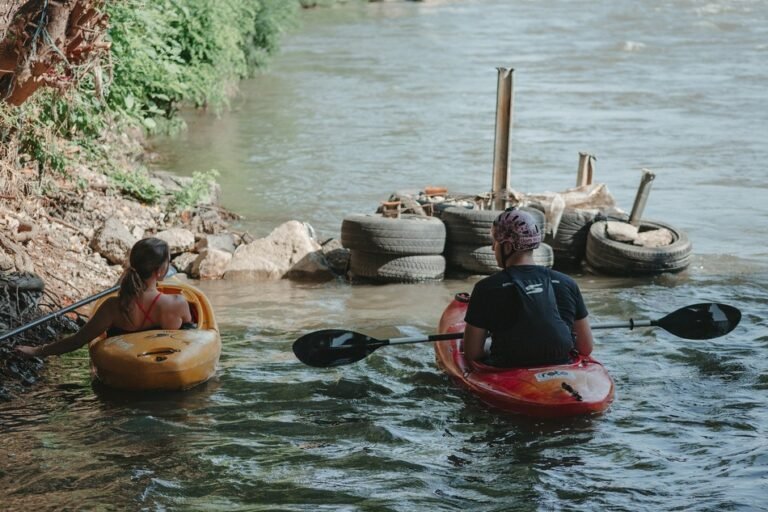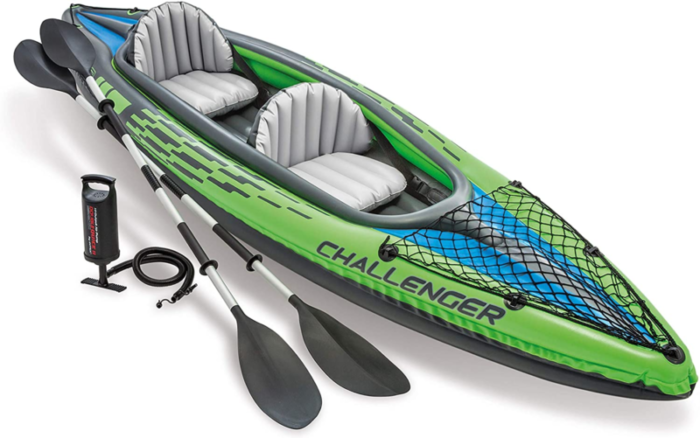What to Wear Kayaking in Fall

When the crisp air of fall arrives, many kayaking enthusiasts look forward to hitting the water before winter sets in. Kayaking in the fall can be a serene and scenic experience as you paddle through waterways surrounded by vibrant foliage.
However, it is crucial to pay close attention to what you wear on these autumn excursions. The fall season has its peculiarity such as shorter days, varying temperatures, and rain drizzle in some places.
It is therefore necessary to dress accordingly. The right attire will give you a pleasant experience and ensure your safety.
Understanding Fall Weather
Before we dive into the specifics of what to wear for fall kayaking, it is important to understand the variations of the fall also known as the autumn weather patterns. The changing elements during this season play a pivotal role in determining the right attire for your kayaking adventure.
Autumn is characterized by a gradual transition from the warmth of summer to the chill of winter. Days become shorter, and temperatures tend to drop as autumn progresses.
Depending on where you live, the weather might vary greatly, but cool, crisp days are typical, especially in the early morning and late afternoon. It is typical to have a large range of temperatures in the fall.
Mornings can be fairly cold, although afternoons can be milder and more comfortable. As you kayak, be prepared for these temperature fluctuations. Wind patterns fluctuate during the fall.
Calm mornings can easily give way to breezy afternoons, and gusts can affect your paddling experience. Wind chill can make the air feel even colder than the temperature suggests.
Rain and rain are more typical in the fall, so you should be prepared to get wet. Rainfall can vary, so having waterproof clothes is essential for staying dry and comfortable.
Given the varying conditions you might encounter during a fall kayaking trip, it’s essential to select clothing that allows for adaptability. Layering is a key strategy to cope with temperature fluctuations. Having multiple layers enables you to add or remove clothing as needed to stay comfortable.
Windproof and waterproof outer layers are particularly important, as they protect against the chilly breeze and potential rain showers. Keep in mind that staying dry is critical in preventing hypothermia. Waterproof gear saves your life when conditions become wet and cold.
Layering for Kayaking in the Fall
Layering is a fundamental strategy for staying comfortable and safe during outdoor activities, especially in the ever-changing conditions of fall kayaking. Layering entails 3 main layers – the base layer, the insulation layer (mid-layer), and the outer layer.
Layering allows for versatility allowing you to adapt to fluctuating temperatures, varying levels of physical exertion, and changing weather conditions. By wearing multiple layers, you can easily add or remove clothing as needed, ensuring comfort and protection throughout your kayaking adventure.
Base Layer Choices for Fall Kayaking
The base layer is the foundation of your attire when preparing for a kayaking adventure. It plays a crucial role in keeping you comfortable and dry throughout your journey.
The base layer is your first line of defense against moisture. Hence, opt for natural materials like merino wool or synthetic materials like polyester or nylon that will keep you dry and prevent chilling by drawing sweat away from your body.
Avoid cotton! It retains moisture which can be comfortable and lead to hypothermia. The base layer helps to regulate your body temperature and prevent chills.
Base layer options for kayaking in the fall
Merino wool
Merino wool is a natural material that is known for its excellent moisture-wicking properties. It regulates body temperature by keeping you warm in cold conditions and cool when it’s warmer. Its ability to resist odor makes it a great choice for multi-day kayaking trips.
While merino wool is highly effective, it can be more expensive than synthetic alternatives. For fall kayaking, your base layer should be thin as thicker options may be too warm.
Synthetic options
Synthetic materials like polyester and nylon are budget-friendly options that offer excellent moisture-wicking capabilities.
They are durable, quick-drying, and often come with built-in UV protection. Many synthetic blends have stretch properties, enhancing flexibility.
While synthetic materials are an excellent option, they may not have the ability to resist odor like Merino wool. Some have been designed to provide additional features like odor control or extra insulation.
Insulation Layer for Fall Kayaking
As the temperature drops during your fall kayaking adventures, having a reliable insulation layer becomes essential for retaining body heat and ensuring comfort.
The primary function of this layer is to trap your body heat and help you stay warm and comfortable in cooler fall temperatures, especially during early mornings and late evenings.
Insulating layer options for kayaking in the fall
Fleece
Fleece is a great option for insulation because it has a great warmth-to-weight ratio, provides good insulation when damp, and dries quickly. They are breathable and are suitable for use in different outdoor activities.
Fleece comes in different weights, so choose one appropriate for the expected temperature. Fleece does not offer much water protection. When it rains, wear it with waterproof outerwear like a dry suit to keep the water out.
Down
Down is renowned for its superior warmth-to-weight ratio, making it incredibly efficient at retaining heat. Down vests and jackets are lightweight and highly compressible, making them easy to pack.
They provide excellent insulation in cold, dry conditions but lose their insulating properties when wet. Pair them with a waterproof outer layer (dry suit) in rainy conditions.
Synthetic options
Other good options that can be worn for insulation in the fall are PrimaLoft and Thinsulate. They are lighter than down and more water resistant.
They maintain some insulating properties when wet, making them a safer choice for kayaking in wet conditions. These synthetic options are less expensive than down alternatives.
A lightweight layer of insulation, such as a fleece vest, may be adequate on milder fall days. For optimal warmth in colder weather, choose a heavier fleece jacket or think about wearing down jackets and vests.
It is crucial to remember that in order to build an efficient layering system, your insulation layer needs to be complemented by the proper base and outer layers.
Your insulation layer should fit comfortably under your outer layer without feeling too restrictive. In the fall, there can be significant temperature variations so choose an insulation layer that can be readily adjusted to fit the condition. The insulation layer should be breathable to prevent overheating.
Outer wears for Fall Kayaking
When preparing for fall kayaking adventures, your choice of outerwear is paramount in ensuring comfort and protection from the elements. Fall often brings increased precipitation, which can lead to wet and chilly conditions on the water.
A waterproof outer layer acts as a barrier against rain, splashes, and the potential of capsizing, helping to keep you dry and warm. When kayaking, it is important that you dress according to the water temperature.
Wind can significantly impact your kayaking experience by causing rapid heat loss through wind chill. A windproof outer layer serves as a shield against gusts and prevents the wind from penetrating your clothing.
Breathable fabrics, such as Gore-Tex, allow moisture and sweat to escape while preventing external moisture from entering.
This breathability prevents you from feeling clammy or sweaty inside your outer layer, enhancing overall comfort. Gore-Tex is suitable for various weather conditions and protects from wind and rain without causing you to overheat.
Outerwear options for kayaking in the fall
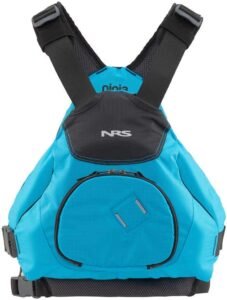
Kayaking Jackets
Kayaking jackets are designed with paddlers in mind, offering features like adjustable cuffs, high collars, and roomy hoods to accommodate a helmet. They often have articulated sleeves for ease of movement during paddling strokes.
An articulated sleeve allows more room around the underarm so that the jacket sleeve will not ride up even when the arm is fully outstretched. Some kayaking jackets come with built-in spray skirts, further enhancing waterproofing.
Kayaking jackets may be pricier than general-purpose rain jackets, but they provide superior functionality on the water.

Drysuits
Drysuits are the gold standard for kayaking in cold and wet conditions. They offer full-body protection against the water. They are entirely waterproof and windproof, so even if you end up in the water, you will be dry and warm.
Drysuits are suitable for extremely cold situations since they can be worn over insulating layers. Drysuits require proper maintenance to ensure the seals remain waterproof.
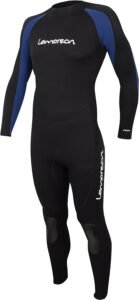
Wetsuits
When the summer is just over and the water is still warm, wetsuits are great alternatives. They keep you warm by trapping a water layer layer between your body and the suit. This makes them suitable for use in warm or cool waters but not in cold waters.

PFD – Personal Flotation Devices
PFDs are non-negotiable safety gear when kayaking in any season, including fall. They provide buoyancy and can be lifesaving in case of accidental immersion or capsizing.
Always wear a well-fitted and approved PFD when kayaking, and ensure it is fastened securely. PFDs designed for paddlers offer a greater range of movement and are more comfortable.
Bottom Wear for Fall Kayaking
Layering is not limited to the upper body only. Your lower body needs to be protected from the elements. Pants are an excellent choice because they provide full lower body protection.
Your pants should be comfortable to allow for a wide range of motion and should be preferably waterproof with adjustable waistbands and ankle bands to keep the water out.
For comfort, your pants should have moisture-wicking abilities and come with pockets. It is important not to overload the pockets so it doesn’t affect your balance when kayaking.
Some find shorts to be more comfortable especially when the weather is mild. Your shorts or pants should be layer-able – they should comfortably fit over your base layer or insulation layer and when necessary under your wetsuit or drysuit.
Lower body options for kayaking in the fall
Pants
Pants provide full leg coverage, protecting you from wind, splashes, and cold water. They are versatile and can be worn with various base and insulation layers. Opt for quick-drying pants with adjustable waistbands for a perfect fit.
The pants should be free and comfortable to sit in for extended periods. Neoprene is an excellent choice for fall kayaking, providing both insulation and water resistance. Neoprene pants are particularly useful when kayaking in cold waters.
They offer a snug fit that seals in warmth and prevents water from penetrating. Neoprene pants are available in different thicknesses, choose one that is suitable for the temperature of the water you will be paddling in. Wearing very thick neoprene pants puts you at risk of overheating if you are paddling in waters that are not as cold.
Shorts
Shorts can be worn on milder fall days when full leg coverage may not be necessary. They offer greater freedom of movement and can be more comfortable in warmer conditions.
If you decide to go for shorts in the fall, be sure to wear insulating base layers underneath to keep your legs warm. Your shorts should be light and made of quick-drying materials.
Footwear for Fall Kayaking
To ensure comfort and safety on the water while kayaking in the fall, it’s important to wear appropriate footwear.
Your feet should be warm and dry. Wet and cold feet can cause discomfort, decreased dexterity, and in extreme situations, hypothermia. To paddle with control and concentration, you need warm, dry feet.
Footwear options for kayaking in the fall
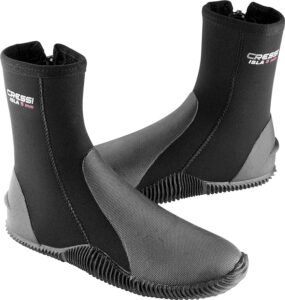
Neoprene Booties
Designed for water sports, neoprene booties are water-resistant and provide good insulation. They keep your feet warm allowing you to enjoy your kayaking expedition.
These booties are lightweight and flexible, allowing for ease of movement and good kayak control. If you require additional stability, you may want to consider hiking boots instead of neoprene booties, as they may not offer the same level of ankle support.
Water shoes
Water shoes are a must-have for anyone who participates in water sports. They have protective soles that protect your feet from abrasions, are designed for easy water drainage, provide good traction, and are lightweight. They are great when kayaking in the fall as they keep your feet comfortable and protected.
Hand Protection for Fall Kayaking
Protecting your hands during fall kayaking is essential to ensure comfort, maintain dexterity, and stay safe on the water.
When kayaking, it is important to safeguard your hands from cold water and wind while maintaining dexterity and a good grip on your paddle. You can protect your hands with neoprene gloves, paddling-specific gloves, or mittens.
In the fall, water bodies can be significantly cooler and the combination of cold water and wind can quickly lead to discomfort and even numbness of your hands.
Protecting your hands is crucial not only for comfort but also for maintaining control of your paddle and making precise maneuvers.
Options for protecting your hands when kayaking in the fall
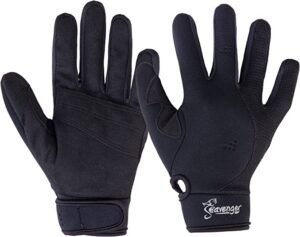
Neoprene Gloves
Neoprene gloves are designed for water sports and provide excellent insulation and water resistance. Neoprene keeps provides insulation even when wet.
You can be assured that these gloves will keep your hands warm, making them suitable for kayaking in colder conditions. Neoprene gloves often offer a snug fit to minimize water entry.
However, they limit dexterity when compared to paddling-specific gloves. They come in varying thicknesses. Choose a thickness appropriate for the water temperature you’ll be kayaking in.
Paddling-Specific Gloves
Paddling gloves are designed with kayaking in mind, offering features like pre-curved fingers and reinforced grip. They provide good dexterity which allows you to control your paddle.
Paddling gloves are versatile and suitable for kayaking in various seasons including in the fall. While they offer protection, paddling-specific gloves they don’t provide the same level of insulation as neoprene gloves in very cold water.
When choosing your hand protection, ensure that grip and dexterity are not significantly compromised as effective paddling requires precise hand movement.
Headwear for Fall Kayaking
Headwear generally keeps your head warm and retains body heat. For protection from impact, consider a kayak helmet.
A significant amount of body heat can be lost through the head, especially in cooler and windy conditions. Proper headwear helps retain heat and contributes to overall warmth and comfort during fall kayaking.
Recommended headwear options for fall kayaking
Neoprene Hoods
Neoprene is commonly used in the manufacture of many of the gears used in water sports. Neoprene hoods are designed to fit snugly over your head and ears, providing excellent insulation and wind resistance.
They effectively retain heat and prevent cold water from coming in contact with your head. Neoprene hoods are versatile and come in many designs. If wearing a neoprene hood, choose one that fits properly and won’t restrict your head movement.
Beanies
Beanies provide some level of insulation without being too restrictive. They are comfortable, lightweight, and easy to pack and carry, making them a convenient choice. While beanies offer warmth, they don’t provide the same level of wind resistance as neoprene hoods.
Recommended accessories
- Sunglasses with UV Protection
Sunglasses protect your eyes from glare and harmful UV rays, especially when kayaking on sunny fall days. Polarized lenses can reduce surface glare on the water, improving visibility. Opt for sunglasses designed for outdoor sports and have secure, comfortable frames to stay in place during paddling.
- Hats with Brims
Hats with brims, such as wide-brimmed sun hats or caps, provide additional sun protection for your face and neck. They can help keep rain or splashes out of your eyes. Look for hats with adjustable straps or chin cords to keep them secured in windy conditions.
- Sprayskirt
If you want to keep water out of your kayak, a spray skirt works nicely. It acts as a waterproof barrier between the kayak’s interior and the water you are paddling in.
During a kayaking journey, sitting in the water might be uncomfortable, particularly if the water is chilly. A spray skirt keeps you comfortable and makes your trip enjoyable.
Safety Considerations for Kayaking In Fall
Safety should always be a top priority when embarking on a fall kayaking adventure. Your flotation device is a necessity for any kayaking trip.
Clothes that are bulky, retain water, or are restrictive, should be avoided. Always have a change of clothes stored in a dry bag, they can come in handy.
The fall season has its peculiarities and they should be taken into consideration when planning to get out on the water. In the fall, the days are considerably shorter and daylight is easily lost.
When kayaking in the fall, set out earlier than you would in the summer to make the most out of the daylight. It is also important to have a light source preferably two, to light your path in case you lose daylight.
Fall weather can bring reduced visibility due to fog, rain, or shorter daylight hours. Being highly visible to other watercraft is crucial for safety, especially if you share the water with motorized boats. We recommend that you wear clothes with high visibility.
Wear bright colors like orange, red, or yellow. Choosing a reflective outer layer or PFD provides enhanced visibility in low-light conditions. Attach a safety whistle to your PFD for signaling in case of emergencies.

